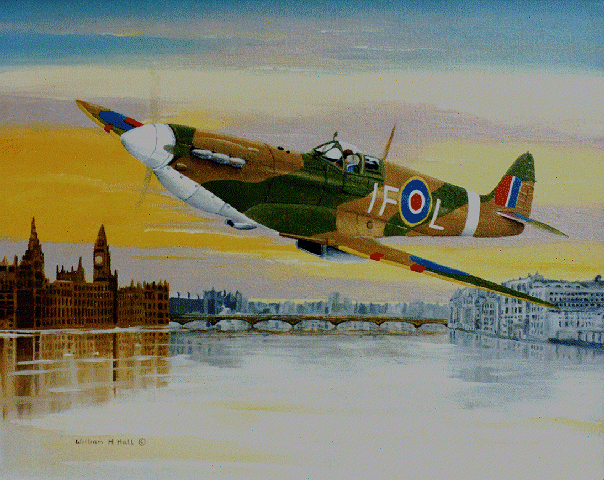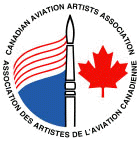


Victory Roll
SOLD
21" x 23" x 1" Oil on Canvas, Framed.
It was not unusual to see pilots doing a victory roll over the Thames River (if they had a combat victory) during the battle of Britain. They usually got in trouble with the civic authorities as well as their Commanding Officers. This was based on a story about one young Canadian officer from Saskatchewan. (Magazine Illustration)
History: Undoubtedly the most famous British combat aircraft of World War II, the Spitfire is as deeply ingrained in the collective psyche of most Britons as the P-51 Mustang is in most Americans'. First flown on 5 March 1936, the Spitfire sprang from the design desk of R.J. Mitchell, who had previously submitted an unsuccessful design for a similar fighter, the Type 224. Once given the freedom to design an aircraft outside of the strict Air Ministry specifications, his Type 300 emerged as a clear winner; so much so that a new Air Ministry specification was written to match the new design.
The Spitfire Mk I became operational at Duxford, Cambridgeshire, in July 1938, and as time went on, the Spitfire was to become one of the most versatile and most-modified aircraft in existence, with various wing designs, armament changes, and engine changes dictating its many identities.
By the time WWII began in September 1939, nine squadrons of Spits were operational with the RAF, and the Spitfire quickly lived up to its good reputation by downing a German He 111 over the UK the following month. Ten more Spitfire squadrons were on strength by the fall of 1940, when the Battle of Britain tested the nation's resolve and military resources. Spitfires soon began overseas operations, in Malta, the Middle East, and the Pacific.
The Spitfire served, and continued to be built, throughout WWII. It served in many theaters, and with many Allied nations, including the USA and the Soviet Union.
The Royal Navy, noting both the success of the Spitfire in land-based service, and also the success of their own Sea Hurricanes, ordered the production of the Seafire, a carrier-based version of the Spitfire. Deliveries began in January 1942, and the Seafire was used in growing numbers and variants throughout the remainder of the war.
While certainly not all-inclusive or comprehensive,
this list of some of the most significant variants of the Spitfire/Seafire gives
some idea of the complexity of the aircraft's history:
* Mk IB: Four 7.7-mm (0.303-inch) guns and two
20-mm cannon;
* Mk VA/B/C: More powerful Merlin engine,
provisions for drop-tanks or bombs, wing and armament changes;
* Mk VII: High-altitude interceptor with
pressurized cockpit and retractable tailwheel;
* Mk VIII: Pure fighter with unpressurized
cockpit;
* Mk IX: Two-stage Merlin engine mated to Mk V
airframe;
* Mk XIV: Griffon 65/66 engine with five-bladed
propeller, strengthened fuselage, broad tail, late models had bubble canopy;
* Mk XVI: Packard Merlin engine, many had
bubble canopy;
* Seafire Mk IIC: Catapult hooks and
strengthened landing gear, Merlin engine, 4-blade propeller;
* Seafire Mk III: Double folding wings and
1,585-hp Merlin 55 engine.
The last operational mission of the Spitfire took place on 1 April 1954, when a Spitfire PR.Mk 19 flew a photo-reconnaissance mission over Malaya. The final mission of the Seafire was in 1967, after many years of faithful service with the Fleet Air Arm and various training squadrons.
The Spitfire, one of the most significant and revered fighter aircraft ever built, continues to steal the lion's share of attention at airshows and fly-ins. The remaining examples are flown with great care, and continued Spitfire restorations ensure that this beautiful aircraft will continue to delight pilots and spectators alike for the foreseeable future.
Nicknames: Spit; Spitter; Bomfire (Spitfires used as fighter-bombers)
Specifications (Mk VA):
Engine: One 1,478-hp Rolls-Royce Merlin 45 V-12 piston engine
Weight: Empty 4,998 lbs.,
Max Takeoff 6,417 lbs.
Wing Span: 36ft. 10in.
Length: 29ft. 11in.
Height: 9ft. 11in.
Performance:
Maximum Speed: 369 mph
Ceiling: 36,500 ft.
Range:
1,135 miles
Armament: Eight 7.7-mm
(0.303-inch) Browning machine guns. (Other variants carried either two cannon
and four machine guns; four cannon; or two cannon, two 12.7-mm machine guns, and
1,000 pounds of bombs.)
Number Built: 20,334 Sptifires; 2,556 Seafires
 Canadian
Aviation Artists Association
Canadian
Aviation Artists Association